The world of regional amusement parks is one that rarely sees a story as captivating or as tragic as that of Geauga Lake amusement park. Located in Aurora, Ohio, Geauga Lake saw more owners, operators and went through more name changes than perhaps any other park in history.
The land on which Geauga Lake would be built was originally just that, land. It was owned by a man named Sullivan Giles, who built his home on the property. As Giles watched the transportation industry change and adapt in the late 1800s, he noticed that a newly constructed train route passed right by his property. He decided to take advantage of the opportunity and established picnic grounds on the property so that train travelers could take a break and enjoy time at the park, located next to the beautiful Giles Pond. As more and more travelers visited the property, Giles built a dance hall on the grounds so that visitors have something to do other than just admire the view or swim in the pond.
Eventually, the area became so popular that the train added a stop right on the property. The picnic grounds and dance hall with the beautiful pond backdrop behind them soon became one of the most popular stops on the rail line, giving people a scenic and relaxing day in northeast Ohio. A steamboat could also be seen that rode around the lake, with a dance floor attached to the back of the boat. In 1887, Geauga Lake Park was officially established. The next year, Major League Baseball games were played at the park and a hotel was built nearby, drawing in more crowds to the area. The park officially became known as an amusement park when a steam-powered carousel was added in 1889.
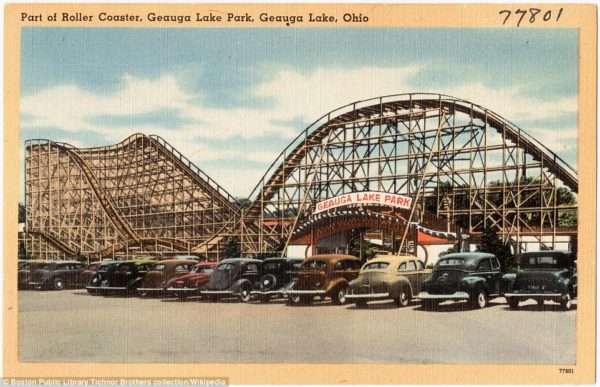
In 1925, the park cemented its place in amusement park history when the Big Dipper roller coaster was built. At the time, it was the largest coaster ever built, with a height of 65 feet and a length of 2,800 feet. Even for today’s standards, those are impressive stats, and this ride was built nearly a century ago. The coaster was designed by John A. Miller and cost around $50,000 to build. To compare, Mystic Timbers, the GCI wooden coaster at Kings Island built in 2017 cost 15 million dollars. Mystic Timbers is about 50 feet higher and 1,000 feet longer than Big Dipper, but still, that goes to show the vast difference in price. The next year, in 1926, an Olympic size swimming pool was built. Shortly after, Tarzan movie star Johnny Weismuller broke the 220-yard freestyle record, while being watched by 3,000 spectators.
Following all of this success, the park experienced some setbacks in the 1950s and 1960s. In 1942 the park was hit by a tornado, six people were injured and the park experienced a lot of structural damages, including damage to the Big Dipper. The park reportedly suffered around $50,000 in damages. Further tragedy struck in 1952 when a massive fire engulfed parts of the park, destroying many key features of the park including the famous dance hall, the theater, the roller rink and the bowling alley, amounting to $500,000 in damages. Also around this time, the park closed the pool, but swimming in the lake continued. Then, in 1969 the park would be changed forever in one of the most explosive chains of events to ever to an amusement park.

Geauga Lake Park was acquired by Funtime Incorporated, a major amusement park manager at the time. Funtime didn’t change much in terms of the park itself, they mainly kept the focus on swimming and recreation at the time. Then, in 1970, SeaWorld Ohio opened across the lake from the park. The parks were actually friendly neighbors, Funtime was actually the one that convinced SeaWorld to build their parks so close together. After SeaWorld was built, Geauga Lake started to focus more on their attractions. Some of the rides Geauga Lake added around this time included a log flume and a 200+ foot observation tower, proving that the park was moving more towards what amusement parks of today look like. The park also built a few steel roller coasters during this time, including the Ron Toomer designed Double Loop from Arrow and Wildcat/Cyclone, a Pinfari Zyklon.
Also during this time, the park switched from free entry to a pay-per-ride system, adjusting for the increased attendance and costlier thrill rides. In 1978, the park added Corkscrew, another Arrow coaster, to the park, making Geauga Lake the first amusement park in Ohio (but certainly not the last) to have two looping roller coasters. In 1983, the park added the beginnings of their water park, calling it Boardwalk Shores. This small section of the park mainly included a few pools and wave pools but would grow with additions of waterslides and more as the years went on. Interestingly, in 1985, the owner of SeaWorld expressed interest in purchasing Funtime, Inc. and combining the two parks. The deal never had much traction, but it sowed the seeds of the many deals and acquisitions that would happen on the property in the years to come. Geauga Lake celebrated its centennial in 1988, and along with some celebrations, the park opened the Raging Wolf Bobs, a bobsled style coaster that cost the park $2 million dollars.
After the centennial had come and gone, the park operated as normal, adding a few flat rides like a Huss Top Spin and other assorted flat rides. Then, in 1995, the park’s history would be changed again when Premier Parks acquired Funtime. This meant yet another new owner for the park, and unlike Funtime, Premier was looking to make some drastic changes to the park’s lineup, mainly focusing on thrill rides. Premier invested $9 million dollars into the park, adding rides like Mind Eraser, which was a Vekoma Boomerang, and Grizzly Run, a river rapids ride designed by Intamin. Both of these attractions opened in 1996, the same year Corkscrew was removed and sold to an overseas park in India. Premier was on a ride buying frenzy, including a 32,000-square-foot water park expansion which included new slides.
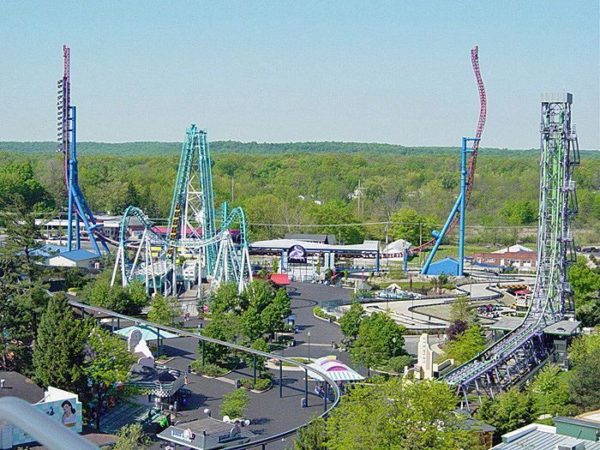
In 1998, Premier made another massive move, this time affecting the entire amusement industry; Premier purchased Six Flags, previously owned by Time Warner. Six Flags was not in a good state at that time, and Time Warner happily sold the chain for $1.86 billion. This affected not only Geauga Lake, Premier now owned all of the existing Six Flags parks. Back at Geauga Lake, Six Flags added Serial Thriller, a Vekoma SLC and other thrilling flat ride additions. Two years later, in an interesting move, Premier did not attach their name to the Six Flags parks, but instead took the name as their own, becoming Six Flags Theme Parks Incorporated and started renaming their parks to the Six Flags brand. Thus, after 112 years, Geauga Lake changed its name in the year 2000, becoming Six Flags Ohio.
(Warning: Epilepsy warning for the following video)
To say 2000 was a great year for roller coasters and theme parks is a vast understatement. Six Flags added 21 roller coasters across their chain, after adding the exact same amount in 1999. To put it into perspective, Six Flags Ohio alone added four roller coasters in 2000, including one family coaster, one wooden roller coaster named Villain, one B&M floorless called Batman: Knight Flight, and one Intamin Impulse coaster called Superman: Ultimate Escape. All of this was part of a $40 million dollar expansion for the park, also including a shoot the chutes ride named Shipwreck Falls, a water park expansion, and additions to the Looney Tunes kids area. The previously small town park was now a full member of the Six Flags family, featuring Looney Tunes and DC theming, and a new Gotham City area.
At the end of 2000, Busch Entertainment (owner of SeaWorld) decided that in order to keep up with the changing amusement park market, they too would start adding roller coasters and thrill rides to their SeaWorld parks. They started changing their parks (Orlando, San Diego, and San Antonio) to fit this model adding rides like Kraken, Steel Eel and Great White to their parks. However, with Six Flags Ohio, Busch decided it would be beneficial to just acquire Six Flags Ohio, and combine their two parks into an amusement park/marine park hybrid, in part due to SeaWorld Ohio’s height limit. So SeaWorld made an offer to buy Six Flags Ohio.
So, after years of extensive additions, buyouts, and lucrative investments, Six Flags Ohio accepted the offer, right? Wrong. Not only did Six Flags not accept SeaWorld’s offer, but they made a counteroffer and purchased SeaWorld Ohio for $110 million dollars in cash. Thrilled to get out of the seasonal operations of Ohio, SeaWorld gladly took the offer and got out of the north, taking their animals with them. Six Flags brought their own animals from Six Flags Discovery Kingdom and populating the marine park with them. The two parks surrounding the lake finally became one and opened for the 2001 season as Six Flags: Worlds of Adventure, the largest theme park in the world.
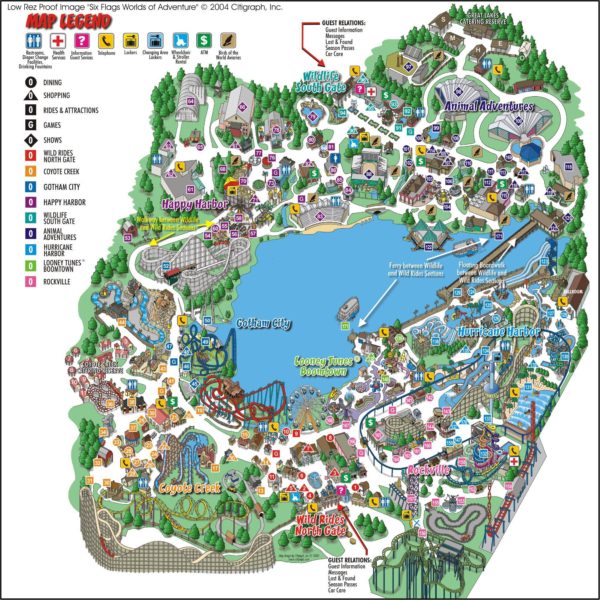
Billed as a “mega park”, the massive 700-acre footprint of Six Flags: Worlds of Adventure was now home to two parks, the Six Flags Ohio side now called the “Wild Rides” section and the former SeaWorld area became the “Wildlife” section. The water park was renamed to the now-standard chain-wide name Hurricane Harbor and received some new slides for the 2001 season. If you think a new park acquisition, water park expansion, and opening of the largest park in the world was enough for Six Flags in 2001, you clearly haven’t been paying attention. New for the summer of 2001 in the Wild Rides section was X-Flight, the first-ever Vekoma Flying Dutchman coaster. This brand new experience allowed guests to feel like they were flying by having the trains hang under the suspended track, with the rider’s backs up, facing the ground.
The park became wildly successful, drawing in more guests than ever before with 2.7 million visitors in 2001. Marketing itself as “three parks in one” due to the water park, the park continued to see growth throughout 2001 and 2002. In 2003, the park built Hurricane Mountain, the largest waterslide complex in North America at the time, because, you know, why not? However, Hurricane Mountain would be the last attraction ever constructed at the park under Six Flags’ ownership.
Due to its massive spending across all of its parks amounting in major debt, Six Flags was having serious money problems and sought to sell some of their parks to try and alleviate some debt. This resulted in the selling off and demolishing of several beloved parks in the following few years, including AstroWorld, Elitch Gardens, Six Flags Belgium, Six Flags Holland, Warner Bros. Movie World parks in Spain and Germany, to name just a few, and Six Flags New Orleans was destroyed by Hurricane Katrina in 2005. The other park to be sold by Six Flags in was, of course, Six Flags: Worlds of Adventure. The massive park had become too much of a management and financial burden for the chain to keep it under their ownership, and attendance fell to only 700,000 guests prior to the 2004 season despite nothing changing with the rides themselves. So the park was sold yet again, this time to Six Flags’ biggest rival: Cedar Fair.
After the $145 million dollar deal was complete, Cedar Fair removed all Six Flags theming including the DC Comics and Looney Tunes characters and areas, as well as reverted the name of the park back to the original, Geauga Lake. Before the reopening in 2004, the marine life section of the park was shut down and the animals relocated to the other Six Flags animal parks. The ride names also had to be changed due to copyright issues, including Batman: Knight Flight changing to Dominator, Mind Eraser changed to Head Spin, Serial Thriller changed to Thunderhawk and Superman: Ultimate Escape was renamed Steel Venom as well as Road Runner Express changing to Beaver Land Mine Ride. So, for the 2004 season, the park reopened as Geauga Lake with no marine park and all remnants of Six Flags ownership stripped. Cedar Fair didn’t add anything additional that season, but in 2005 they built the $26 million Wildwater Kingdom, a large water park located on the previous SeaWorld property.
In 2006, the state of the park was near dire. The Geauga Lake water park had closed, leaving Wildwater Kingdom to be the only water park on the property. Also in 2006, the park changed to summer-only operation, open from Memorial Day to Labor Day. Prior to the 2007 season, Cedar Fair relocated X-Flight to Kings Island under the new name Firehawk (demolished in 2018), and Steel Venom was moved to Dorney Park and its name was changed to Voodoo (now called Possessed). Removing two major attractions, especially roller coasters, is never a good sign, and unfortunately, that was true for the case of Geauga Lake. The last day of operation, unbeknownst to guests, was September 16th, 2007. On September 21st, 2007, Cedar Fair announced that the park would not be reopening. Instead Wildwater Kingdom would be the only park operating on that property and all Geauga Lake rides would be demolished or relocated. Wildwater Kingdom would close in 2016.
This was an extremely tragic ending to an extremely tumultuous and storied history of one of America’s oldest and most beloved amusement parks. Speculation and blame have flown around in the years during and following its closure, with some blaming Six Flags for giving a messy managed park to Cedar Fair, some blame Cedar Fair and accuse them of buying the park for the sole reason of relocating the rides in mind from the beginning. In the end, we will most likely never find out exactly what lead to the park’s closure. What we do know is that fans of the park received no warning to get their last rides in, take their final pictures, collect their final maps, buy their last souvenirs, or say their last goodbye. Locals were devastated, especially when classic rides like the Big Dipper, Villain, Double Loop and Raging Wolf Bobs were demolished after failing to receive a bid.
Some rides survived, however. Dominator is currently operating at Kings Dominion under the same name, Head Spin is now at Carowinds, called The Flying Cobras, and Thunderhawk is open at Michigan’s Adventure, retaining its name as well. Demon Drop at Dorney Park was relocated from Cedar Point in 2009, and it uses some of the parts from Mr. Hyde’s Nasty Fall, a clone of the ride at Geauga Lake. There is a multitude of photos, videos, and other footage of the state of the park now, I encourage you to check them out and do additional research, the history of the park is truly fascinating. Geauga Lake may be gone, but it lives on in the memories of those who visited it and the fans who take the time to learn and research its fascinating history.

Some interesting links:
A promotional video from 1982 showing some beautiful footage of the park: https://www.youtube.com/watch?v=oYzbFvlSUkQ
Various walk through videos through the years:
- 1998: https://www.youtube.com/watch?v=ID6Eg8VSs5M
- 2003: https://www.youtube.com/watch?v=tfLmwkjwpek
- 2004: https://www.youtube.com/watch?v=kI4-Ld-261g
Geauga Lake in 2016 via drone footage: https://www.youtube.com/watch?v=Civ9F9dBBFI
Various maps throughout the park’s history: http://www.rollercoasterfreak.com/Geauga_Lake/Maps/GL_Maps.html
Our own article about the photography of the abandoned park: http://c101.co/2xtZ8by
Were you able to visit Geauga Lake before it closed? Share your memories or stories from the park in the comments section below.

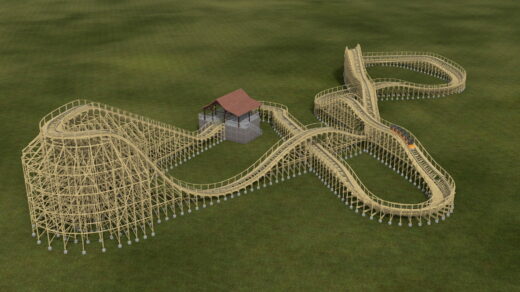












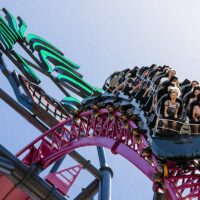
Thanks for a trip down memory lane. A sad, reminiscent trip. This was my home park. My original park. The one that started this over a decade of hobby. Very nice report, great history and good notes on how crazy of a trip this park took. This park could likely fill a couple books worth of notes. One I also add in is Cedarfair’s purchase of the five Paramount parks in 2006 for 1.24 billion. The same time they are dealing with Geauga Lake. There is also a very interesting history of the managers and the chain of knowledge. From my understanding, at some point a group of management broke off from Cedar Point to Geauga lake and maybe even moved into six flags. There is also another similar chain of knowledge for wooden roller coaster design with many companies coming from older ones. Could make a cool blog post (wink), wood coaster companies traced back to Philadelphia Toboggan Company. Back to Geauga Lake it’s dearly missed and with over a hundred years of history, everyone in north east Ohio has some memory of the park. With all the other small amusement parks in the area closed, leaving a over crowded Cedar Point, I really miss my time there.
I visited Gauga lake back in 1990 with my girlfriend and her 2 kids a couple of times and it was OK! I was shocked to here of its closing.
hear. 🙂
My wife and I visited the park in 1971, during a weekend when the weather was perfect. It was so unusual for the area of northern Ohio to have such nice weather, that later that year when engaged in a conversation with a new acquaintance and they asked me if I had ever been to Geauga Lake came up, I mentioned that I had been there the previous summer during that weekend of two nice days, and that person immediately knew the weekend I meant
Thank you so much for sharing! Glad to hear that you had a happy memory of the park.
Such a cool story bro.